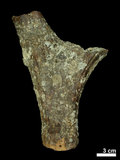象齒生長與發育
推薦分享
後設資料
- 資料識別:
- 系統識別碼:0b00000180ab9717
- 資料類型:
- 型式:合集
- 紀錄類別:脊椎動物化石知識單元
- 主題與關鍵字:
- 學域-大分類:地質-化石類
- 分類:脊椎動物化石
- 拉丁界名:Animalia
- 中文界名:動物界
- 拉丁門名:Chordata
- 中文門名:脊索動物門
- 拉丁亞門名:Vertebrata
- 描述:
- 簡介:『大象長長的鼻子真昂揚,全世界都舉起了希望』。說起大象無不令人嘖嘖稱奇。它具有宛如手指般靈活的長鼻,它具有大扇子般的外耳,它具有挖掘、爭鬥、禦敵等多功能的大門牙,它曾經昂首闊步5000萬年,足跡遍佈全球…。然而,在生物學家的眼中,大象更具有一項獨一無二的特徵,即“前仆後繼、接踵而至”的臼齒生長方式。
- 大象的一對“獠牙”是由上門齒發展而成,沒有牙根,終生持續生長。大的雄性非洲象的門齒就可以長至3公尺。除了巨大的門齒之外,大象頰齒的生長方式最為特殊。頰齒包括了前臼齒與臼齒,一般動物的頰齒都是排列在牙床內,每個牙齒皆由下往上(下頰齒)或由上往下(上頰齒)生長。大象的頰齒則是在牙床內從後邊斜著向前發生和長大,而且一顆接著一顆,連續地、輪流地向前伸展。上顎的牙齒的發生是從後向前、向下移動生長;下顎的牙齒的發生則是向前、向上移動生長。牙齒的齒板是以傾斜的位置被磨掉。當它慢慢地生長和向前推進時,會把前一個牙齒逐漸擠掉,並取代其位置。大象終其一生每一側每一邊各有六顆牙齒(三顆前臼齒、三顆臼齒)可供輪替使用,亦即總共有24顆頰齒。而且隨著年齡的成長,牙齒有愈來愈大、齒板數目有愈來愈多的趨勢,因此,從牙齒的大小與齒板的數目,我們就可以來推斷大象的年齡。
- 大象頰齒斜向磨蝕的方式,大大地增加了磨面,以便大量地研磨食料。同時,這種一個接著一個輪替接續的頰齒生長方式,更大大地提高牙齒使用的年限。一般草食動物的壽命,與牙齒的使用年限有絕對的相關,一旦牙齒磨蝕耗盡,則無法再進食而告死亡。大象不像其它草食動物全部頰齒同時使用,而在一定的年限全部磨完。它採取前仆後繼、接踵而至的方式,提高頰齒使用的年限,而同時也增加了大象的生存年限。相對於其它草食動物,大象顯然長壽多了,一般非洲象年齡可達到60-70多歲,大家熟悉的林旺爺爺—亞洲象已高齡80了。它們的長生之道就是有那特殊的前仆後繼、相互接力的生長且與攝取食物息息相關的頰齒。Mammals Development of Elephant Teeth哺乳動物化石象齒生長與發育The elephant's long trunk rising high, lifts up hope around the world". The elephant is an amazing creature. It has a trunk that is as nimble as fingers, large fan like ears, huge incisors for digging, fighting and defense, and it once strode across the planet for 50 million years. For biologists, what's really unique about elephants is how its molars "keep heading to the front, continuously ".
- The elephant's "tusks" grow from the upper incisors and have no roots. They continue growing throughout an elephant's lifetime. In large male African elephants, their incisors can grow to a length of 3m. Apart from their huge incisors, the elephants' cheek teeth grow in an unusual manner. The cheek teeth include premolars and molars. In most animals, the cheek teeth are lined up inside the mandible and each grow up (lower cheek teeth) or down (upper cheek teeth). In the elephant, the cheek teeth point slightly forward when they erupt and continue growing to the front. Teeth in the upper mandible erupt pointing forward and gradually move downwards. The teeth in the lower mandible erupt pointing forward and gradually grow upwards. The tooth-plates are gradually worn away at an angle and, as they gradually grow and move forward, squeeze out and replace the previous teeth in the position. This means elephants always have 6 teeth (3 premolars and 3 molars) on each side guadrant being used in rotation throughout their lifetime, for a total of 24 cheek teeth. As they age, the teeth become bigger and the number of tooth plates increase in number as well. The size of the teeth and number of tooth plates therefore offer a way to estimate an elephant's age.
- The way that elephants’ cheeks grow and erode away at an angle greatly increases the grinding surface so they can grind up large amounts of food. The way that each cheek teeth grows one after another greatly increases how long the teeth can be used. For most herbivores, how long their teeth last determines how long they can live. Once their teeth are all worn away, they can't feed anymore and starve to death. Unlike other herbivores, the elephant doesn't use all of its cheek teeth at the same time and wear them all away after a set number of years. Instead, the continuous "keep heading to the front" method extends the cheek teeth's service life and greatly boosts the elephant's lifetime. This means the elephant lives significantly than other herbivores. Generally speaking, the African elephant can reach 60 to 70 years of age while "Granddad Lin Wang", the Asian elephant we are all familiar with, lived to an age of 80. Their long life can be attributed to how the cheek teeth they use to feed grow one after another in a relay format.
- 出版者:
- 數位化執行單位:國立自然科學博物館:地質學組脊椎動物化石學
- 管理權:
- 典藏單位:國立自然科學博物館
- 使用聲明:館內公開瀏覽
授權聯絡窗口
- 鍾舜丞
04-23226940*762
chungnmns@nmns.edu.tw






